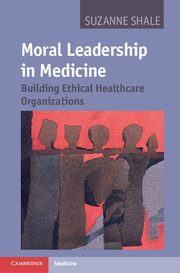Book contents
- Frontmatter
- Contents
- Preface
- Acknowledgements
- Chapter 1 Why medicine needs moral leaders
- Chapter 2 Creating an organizational narrative
- Chapter 3 Understanding normative expectations in medical moral leadership
- Prologue to Chapters 4 and 5
- Chapter 4 Expressing fiduciary, bureaucratic and collegial propriety
- Chapter 5 Expressing inquisitorial and restorative propriety
- Epilogue to Chapters 4 and 5
- Chapter 6 Understanding organizational moral narrative
- Chapter 7 Moral leadership for ethical organizations
- Appendix 1 How the research was done
- Appendix 2 Accountability for clinical performance: individuals and organizations
- Appendix 3 A brief guide to commonly used ethical frameworks
- Index
- References
Appendix 3 - A brief guide to commonly used ethical frameworks
Published online by Cambridge University Press: 05 January 2012
- Frontmatter
- Contents
- Preface
- Acknowledgements
- Chapter 1 Why medicine needs moral leaders
- Chapter 2 Creating an organizational narrative
- Chapter 3 Understanding normative expectations in medical moral leadership
- Prologue to Chapters 4 and 5
- Chapter 4 Expressing fiduciary, bureaucratic and collegial propriety
- Chapter 5 Expressing inquisitorial and restorative propriety
- Epilogue to Chapters 4 and 5
- Chapter 6 Understanding organizational moral narrative
- Chapter 7 Moral leadership for ethical organizations
- Appendix 1 How the research was done
- Appendix 2 Accountability for clinical performance: individuals and organizations
- Appendix 3 A brief guide to commonly used ethical frameworks
- Index
- References
Summary
‘The Four Principles’; aka ‘the Georgetown mantra’
Healthcare professionals frequently refer to ‘principlism’ because it is widely taught in medical schools, and often permeates specialty curricula. It was developed by leading US bioethicists Tom Beauchamp (of Georgetown University) and James Childress. They argue that their framework encompasses all the moral considerations that are relevant to healthcare, that it is universally applicable, and that it reflects a common morality. In the UK its main proponent has been the distinguished and influential medical ethicist Raanan Gillon.
The principles are:
Respect for patient autonomy. This means that where possible decisions should be made so as to protect and promote patients' exercise of deliberated self-rule. Patients should be supported to make their own decisions, and where they are unable to decide (because they lack capacity, for example) everything possible should be done to promote future capacity or to act consistently with their known views.
Non-maleficence. This appears at first to be a negative duty: to refrain from doing anything that will harm patients, often recalled in the Latin phrase primum non nocere. However, it also implies taking strenuous steps to ensure that patients do not incur harm in medical settings, for example by using theatre checklists to ensure patient safety during surgical operations.
Beneficence. This appears at first to be a positive duty: act so as to promote patients' overall well-being. It also implies, though, sometimes not acting, for example adopting a stance of ‘watchful waiting’ or ‘masterly inaction’ in order to best manage a patient's condition.
Justice. Justice in this context means, primarily, to adjudicate fairly between competing claims and to treat patients as equal to one another.
- Type
- Chapter
- Information
- Moral Leadership in MedicineBuilding Ethical Healthcare Organizations, pp. 292 - 295Publisher: Cambridge University PressPrint publication year: 2011



